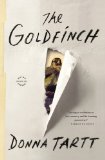Summary | Excerpt | Reviews | Beyond the Book | Read-Alikes | Genres & Themes | Author Bio

A Novel
by Donna TarttThis article relates to The Goldfinch
 In Donna Tartt's new book, the protagonist, Theo Decker, comes upon an original seventeenth century painting, "The Goldfinch". The painting is one of Carel Fabritius' (Fub-reet-zee-us) most famous works. Fabritius (1622-1654) was one of Rembrandt's pupils. He worked from the Dutch city of Delft and produced only a small body of work before his death in a gunpowder explosion that shook the city in 1654, killing hundreds. Although a student of Rembrandt, Fabritius branched away from his master in his use of cool color schemes and especially his use of perspective - a technique that would surface later in the work of Vermeer.
In Donna Tartt's new book, the protagonist, Theo Decker, comes upon an original seventeenth century painting, "The Goldfinch". The painting is one of Carel Fabritius' (Fub-reet-zee-us) most famous works. Fabritius (1622-1654) was one of Rembrandt's pupils. He worked from the Dutch city of Delft and produced only a small body of work before his death in a gunpowder explosion that shook the city in 1654, killing hundreds. Although a student of Rembrandt, Fabritius branched away from his master in his use of cool color schemes and especially his use of perspective - a technique that would surface later in the work of Vermeer.
 Fabritius was known to use special optical effects and slight distortions in his paintings. Dutch artists of the time specialized in the use of peep boxes to add perspective. A peep box is a painting inside of a constructed rectangular box. The four interior walls are painted according to specific techniques and then a peephole is carefully placed. When the painting is viewed through this peephole, an illusion of depth and perspective is achieved.
Fabritius was known to use special optical effects and slight distortions in his paintings. Dutch artists of the time specialized in the use of peep boxes to add perspective. A peep box is a painting inside of a constructed rectangular box. The four interior walls are painted according to specific techniques and then a peephole is carefully placed. When the painting is viewed through this peephole, an illusion of depth and perspective is achieved.
 Fabritius is especially known for the trompe l'oeil (deception of the eye) technique - an art method by which two-dimensional objects on a surface appear to be in three-dimensional space. This is one of the many hallmarks of "The Goldfinch", which is now housed in The Mauritshuis, a major art museum in The Hague. The painting shows a goldfinch on a rail in front of its feed box, which is itself positioned against a white wall. The goldfinch is anchored to the rail by a thin chain around its ankle. The shadows created by the bird and the feedbox add to the trompe l'oeil effect.
Fabritius is especially known for the trompe l'oeil (deception of the eye) technique - an art method by which two-dimensional objects on a surface appear to be in three-dimensional space. This is one of the many hallmarks of "The Goldfinch", which is now housed in The Mauritshuis, a major art museum in The Hague. The painting shows a goldfinch on a rail in front of its feed box, which is itself positioned against a white wall. The goldfinch is anchored to the rail by a thin chain around its ankle. The shadows created by the bird and the feedbox add to the trompe l'oeil effect.
 Because "The Goldfinch" was painted on a very thick panel, there was much speculation as to whether the painting was originally meant to be part of a door, especially one to be placed at a height making use of the painting's trompe l'oeil effects.
Because "The Goldfinch" was painted on a very thick panel, there was much speculation as to whether the painting was originally meant to be part of a door, especially one to be placed at a height making use of the painting's trompe l'oeil effects.
The goldfinch, a common pet in Holland at the time, could be taught to perform tricks, such as drawing their own drinking water from a cup using a small thimble.
First image: Carel Fabritius
Second image: Samuel van Hoogstraten's peepshow of Interior of a Dutch House
Third image: A great example of trompe l'oeil, Escaping Criticism by Pere Borrell del Caso, 1874
Fourth image:Carel Fabritius' The Goldfinch
Filed under Music and the Arts
![]() This "beyond the book article" relates to The Goldfinch. It originally ran in November 2013 and has been updated for the
April 2015 paperback edition.
Go to magazine.
This "beyond the book article" relates to The Goldfinch. It originally ran in November 2013 and has been updated for the
April 2015 paperback edition.
Go to magazine.
Your guide toexceptional books
BookBrowse seeks out and recommends the best in contemporary fiction and nonfiction—books that not only engage and entertain but also deepen our understanding of ourselves and the world around us.